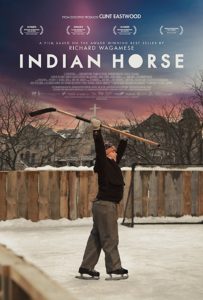Opinion: review of Indian Horse film
By Kristin Grant
Scenes in the film “Indian Horse” can be tough to watch, but are nonetheless important. They serve as a reminder of our past which should never be forgotten, especially when as we as a Canadian society struggle to reconcile our history with First Nations.
The film is an adaptation of the 2012 Richard Wagamese novel of the same name and was part of the 2017 Toronto International Film Festival. The story begins in 1959 and focuses on Saul Indian Horse, a six-year-old Ojibway boy, who is put in residential school. It examines the effect that has on his life. Seeing the atrocities play out in front of you has a way of making it more real for those who never experienced it in a way that reading about it doesn’t.
Never having gone to residential school myself, I can only imagine what difficult memories it would trigger for survivors. I can only hope that my relatives didn’t experience or witness the level of abuse depicted. They were never far from my thoughts as I watched.
I would even go so far as to say this film should be mandatory viewing for high school students, especially in these days of truth and reconciliation. Future generations need to understand the past so it won’t be repeated.
While the movie delves into some dark territory, there are some brief moments of levity. One that sticks out in particular is when young Saul, desperate to learn hockey, teaches himself to shoot with frozen horse dung as pucks.
Saul proves to be a talented hockey player with a bright future ahead of him. It is heartbreaking to see him downward spiral when unexpectedly confronted with his past. This makes it difficult to deal with the racism directed towards him.
The film’s final message is very timely, that in order to heal we need to return to our roots. Very fitting as we endeavor to maintain our traditional ways.
Aside from the emotional story line, this film has a lot going for it. Gorgeous cinematography that showcases Canada’s natural beauty. Director Stephen S. Campanelli keeps the story’s pacing consistent and the audience engaged.
The production value is great, from costumes to sets where the audience is transported in time from the 60’s to the 70’s and even the 80’s. They also do an excellent job of creating a dismal atmosphere of the school itself.
Lastly are the three talented actors tasked with bringing Saul to life. Each bring something different, Salden Peltier’s young Saul has a youthful exuberance and Forrest Goodluck portrays teenage angst. Ajuawak Kapashesit plays adult Saul, a man down but not out struggling with his demons.


